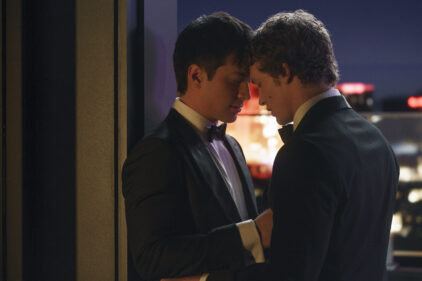Early in HBO Max’s breezy, effervescent new series “Minx,” opportunistic porn mag producer Doug Lanetti (Jake Johnson) breaks down his philosophy of inserting full-frontal male nudity in Joyce’s (Ophelia Lovibond) feminist magazine: It’s like hiding your dog’s heartworm pill in peanut butter. If you want people to read serious-minded essays about equal pay and abortion rights, you’ve gotta break it up with something fun. A spoonful of dick, after all, helps the politics go down.
It’s that ethos that pervades writer/producer Ellen Rapoport’s endlessly charming new series, one that relishes in the breeziness of the sexual revolution of the ‘70s without wholly dismissing the gender issues at play in its central idea. It’s thoughtful but unapologetically filthy all at the same time, a kind of pervert’s alchemy that miraculously works.
Central to “Minx”‘s juggling act between feminism and flesh is the back-and-forth between its central duo—buttoned-up, second-wave feminist Joyce and devil-may-care skin merchant Doug. In the opening scenes of the pilot, the latter finds the former at a magazine publishing conference in 1970s Los Angeles, where Joyce’s strident lecturing about women’s rights fall on deaf ears among the good ol’ boys she pitches to (“Why is she so angry?” one asks of the screaming woman, fist raised, on the magazine’s cover). But Doug sees something in her pitch, whose original title is the oh-so-catchy “The Matriarchy Awakens,” especially when some of his nude models read it and it catches their eye. Sensing an opportunity, he brings the reserved Joyce on board with his porn-mag company (Bottom Dollar, natch) with an idea: Put nude male centerfolds in between hard-hitting essays about birth control, and you’ve got the stuff to break into an as-yet-untapped market.
From there, “Minx” charts Joyce’s tip-first plunge into the world of pornography, mining her uptight reservedness (she cops to only having seen “two and a half” penises in her life before this) for plenty of transgressive gags about the limits of her own conception of feminism. She’s steeped in the quote-unquote “angry feminism” of the second wave: she sings loudly in the car to “I Am Woman, Hear Me Roar”, and her perpetual uniform is a corduroy three-piece power suit. When she starts working with Doug, she gets nightmares about Gloria Steinem pelting her with tomatoes.
Contrast that with Doug, played by Johnson in that quintessential laidback persona he’s curated since “New Girl.” But Doug isn’t quite as unambitious as Nick Miller, far from it—his carefree slouchiness hides a business savvy that makes him a force to be reckoned with, even when he’s underestimated by everyone from publishers to the Italian mob. He’s on board with Joyce’s feminism—”making shit fair and equal for the chicks,” he defines it—but also sees the magazine as an opportunity to break into a niche heretofore broached only by Burt Reynolds’ hairy thigh draped over a bearskin rug.

Done with a little less care, Joyce’s journey from closed-off killjoy to savvy dong-displayer could read as a tale of uppity feminists needing to calm down a bit and not take things so seriously. But “Minx,” like its titular publication, stuffs a healthy amount of medicine inside that chunky penis butter. Yes, it’s a gas to see Joyce wince at the cavalcade of nude models they bring in to populate their first issue (leading to a montage of wedding tackles spanning lengths, widths, and girths that would make “Zola” blush). But it also serves as an endearing reminder that yes, penises exist, and can be enjoyed in the right context.
It’s just one of many wake-up calls for Joyce in the series’ first few episodes, especially as she learns both that the porn industry has the potential for facilitating liberation in its own right, and that her rigid ideas of feminism may not be as liberatory as she thinks. Joyce’s journey gives Lovibond plenty of layers to play, and she gives a fun, capable leading turn that doesn’t shy away from the more selfish sides of the character’s persona. When she finds herself in an office fling with Issue 1’s cover model, the delightfully dim but hung-like-a-firehose jumbo Shane (Taylor Zakhar Perez), she justifies it as being the same kind of power dynamic men in power get to enjoy. An afternoon spent with a gaggle of Italian housewives—the very people she’d normally hector to get out of the kitchen—turns into an eye-opening look at an aspect of womanhood she wouldn’t typically experience. Bit by bit, Joyce learns there’s more to feminism than can be found in the works of Germaine Greer,
But “Minx” never gets bogged down in lectures, the whip-smart script and breezy direction keeping things light and bouncy (like a fair few of its models, regardless of gender). Surrounding Doug and Joyce are a game ensemble of supporting characters with their own things going on, from the ditzy but deceptively smart Bambi (Jessica Lowe) to ambitious gay photographer Richie (Oscar Montoya). Doug’s right-hand woman Tina (Idara Victor) is easily the most pragmatic of the group, holding the operation together while still dealing with the everyday racism of the office. “Oh, I’m not a secretary,” she says coldly when Joyce asks her for a coffee. “I’m just Black.”
At no point does “Minx” pretend to exist in anything other than a candy-coated fantasy version of 1970s LA, where the sex work we see is handled with complete ethics, Black women get to hold senior positions of authority, and Phyllis Schlafly-esque moral crusaders can be outwitted with the right amount of gumption. But so far, what we’ve seen of “Minx” is downright addictive, from its groovy period-appropriate costumes to the careful balance of sleaze and satire. It’s a real page-turner, but you’ll enjoy “Minx” for more than just the articles.
The first five episodes were screened for review.












